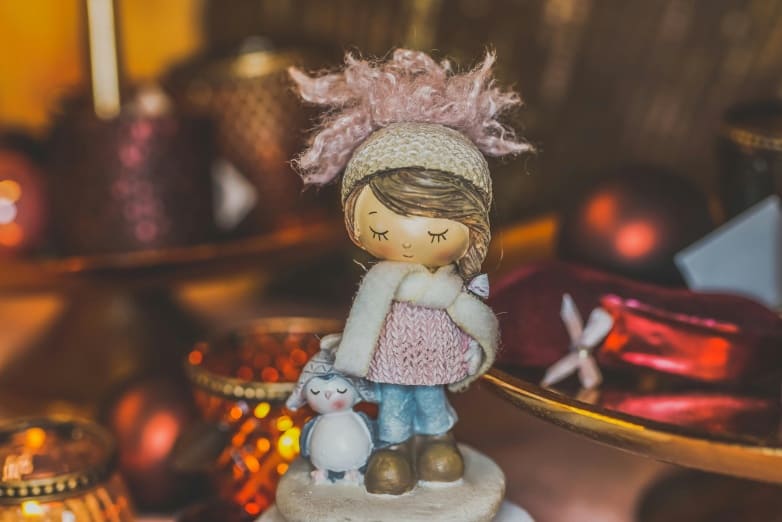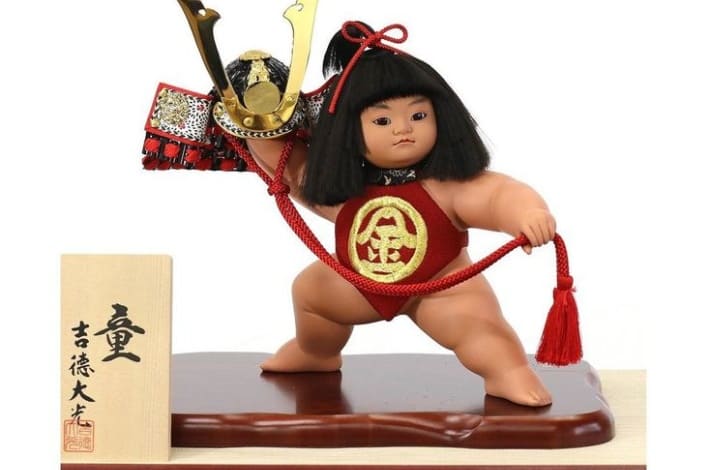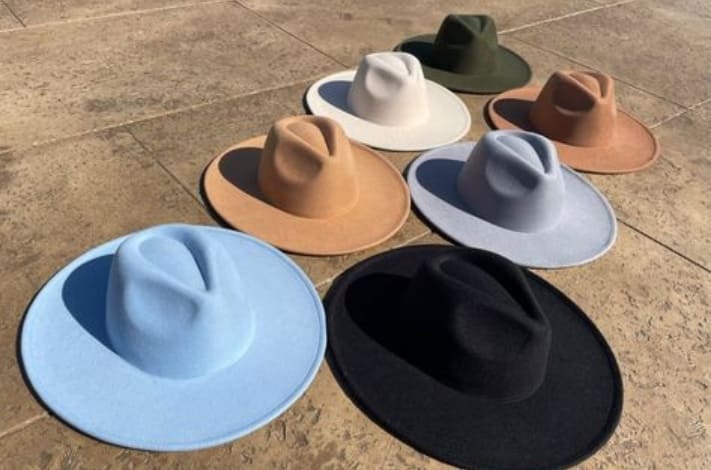Dolls are universal toys; almost every culture in the world has them. They have a rich history, especially for their owners and cultures. Private collectors own some of these, and at times, they fetch a lot of money once auctioned. Japanese traditions also include a rich heritage of various types of dolls, which we are going to explore in this article.
How deeply rooted the dolls’ culture is in their tradition will surprise you! Here are 15 types of traditional Japanese dolls.
#1) Kokeshi Doll
This is a Japanese doll originating from northern Japan, in the Tohoku region, after the mid-Edo period. The Kokeshi doll is gorgeous; you will find it mainly at the hot springs resorts. Cylindrical-formed waste wood makes the doll’s structure with the addition of eye-catching, finely painted features. They have a head and body but no limbs.
Initially, children gifted this doll as a prayer for their good health, to ward off evil spirits, and to prevent fires. Later, they found their way into the world of arts when gifted to tourists. This allowed more modernization and the imaginative creation of the Kokeshi doll as a true and unique Japanese doll.
Both traditional and modernized Kokeshi dolls in Japan are well-liked souvenirs, and there is a subset of collectors. If a Kokeshi doll appeals to you, make sure to keep an eye out, as different Onsen towns have a variety of regional styles!
#2) Gosho Ningyo Dolls
Gosho dolls are also also known as palace dolls or white chrysanthemum dolls. Willow tree trunks shaped like a baby boy make the appearance of the doll great. During the Meiji era, it gained the name Gosho. During the Edo era, the Emperor gifted them to feudal lords. These dolls symbolize chubby and cuddly babies born in the palace; hence, they are easily recognizable.
These dolls are painstakingly made from wood and crushed oyster shells, then painted and clothed by hand. A single doll might take up to six months to complete. Did you hear that? This fact makes one appreciate the value of exquisite pieces of art. As a result, they act as good wedding gifts, and during childbirth, they convey the intention that the children will grow up healthy and content. 
#3) Daruma Dolls
Well known for being a “seven falls, eight rises” lucky charm. The Daruma doll is a circular object with no limbs. Daruma was the third son of the King of South India, or so the narrative goes. He was an extremely pious Buddhist. His life’s work was to introduce Buddhism throughout his nation. Later on, he relocated to Suzan Shorinji in China.
He spent the next nine years meditating on the wall there. Eventually, his limbs deteriorated. As such, the Daruma doll is, therefore, merely a circle block with no limbs. Daruma has since come to represent perseverance and commitment to all things.
#4) Kimekomi Dolls
The Kimekomi doll gives credit to Tadashige Takahashi, an artisan who worked around 1740. He made dolls out of pieces of willow wood. The original name of these dolls was Kamo. Subsequently, they adopted the name Kimekomi.
In Japan, Kimekomi dolls are highly popular, unique, and adorable. The hand-painted face is the unique feature of every doll. Owing to their small size, sets of them are frequently assembled together. Kimekomi is a symbol of sweetness, diminutive size, and cuteness. Additionally, this represents the archaic Japanese woman. In their traditional kimonos, they are quiet and extremely gentle.
#5) Hinamatsuri (Hina) Dolls
These unique dolls have a connection to the Japanese Doll Festival, which takes place on March 3rd each year. Families set up shrines in their houses yearly with figurines of the Emperor and Empress, known as Hina dolls.
Families leave rice cake offerings at the elaborately constructed altars. Throughout the lengthy history of Japan, several places and times have created their own versions of Hina dolls and their altars.
#6) Kyoto Dolls
The Kyoto doll, sometimes referred to as Kyo Ningy, is a type of traditional Japanese doll. It gets its name from its manufacturer, which is located in Kyoto. Their craftsmanship is a tradition passed from generation to generation by subtle, thorough, and caring artisans.
Kyoto dolls demand artists’ sophistication and attention to detail. It takes a talented team of artisans to create a Kyoto doll. Each craftsman will be responsible for combining their crafts into one when making a doll, hence developing their worth. The artists’ attention to detail and caution give the dolls value, as they have a strong desire to instill Kyoto’s soul.
#7) Geisha Dolls
An antique Japanese geisha doll is a representation of actual geishas. Geisha are ladies who have received training to perform musical acts, dance, and sing at social events for the affluent. In contrast to Oiran, geisha do not sell their bodies. They merely used their beauty to perform for their patrons. Even today, geisha continue to have a striking image when they wear vibrant kimonos and hold musical instruments.
#8) Iki Ningyo Dolls
Iki Ningyo is a maker of life-sized dolls. During the Edo period, they were frequently on display in Misemono exhibits and crafted by artisans based on gods and historical people. These days, people immediately think of store mannequins when they hear the word Iki Ningyo.
#9) Kintaro Dolls
“Golden Boy” is a common translation for Kintaro Doll. Within Japanese folklore, this character is heroic. Kintaro is a lucky charm representing bravery, strength, and good fortune. Boys are typically given Kintaro on May 5th, symbolizing a wish for a strong, courageous, and fearless body.
#10) Oiran Dolls
The Oiran doll is a recreation of a real-life Oiran, a high-class courtesan from Japan’s Edo era. The form of Oiran dolls is particularly appealing, just like a Japanese Barbie. One could argue that they are the most exquisite in all of Japan. The artists have given meticulous attention to aspects like makeup, outfits, and other features that include accessories. Like the genuine Oiran, every doll is a unique character with a soul and class of its own.
#11) Okiagari Koboshi Dolls
Round, plump paper-mache dolls known as Okiagari Koboshi dolls first appeared in the fourteenth century. Another name for them is roly-poly. The Okiagari Koboshi doll’s structure is comparable to that of Darumas. They are also thought of as amulets that promise health, happiness, and protection from illness.
#12) Hakata Dolls
The Hakata Ward of Fukuoka City is the birthplace of these dolls. These are clay dolls in various forms, but “the beautiful one,” a stunning woman donning a silk kimono with intricate patterns, is the most well-known and well-liked. Painstaking care goes into making the dolls, particularly in painting the delicate facial characteristics, handcrafted with a very small brush for each doll. These are stunning pieces of art.
#13) Ichimatsu Ningyo Dolls
Sanogawa Ichimatsu, a well-known Kabuki actor, is the basis behind these dolls. They are works of art as well as gifts for girls, and they were originally made in 1750. They can wear a wide variety of costumes. Costlier dolls are highly poseable for play or exhibition since they have head, torso, and leg joints.
#14) Gogtasu Dolls
These are Japanese traditional dolls meant for boys. On May 5, they display them on an altar in an intended symbolic gesture of peace and well-being for the kids. Old samurai households have a custom whereby the parents of each newborn decorate the Gogatsu dolls in front of the house to bless them, all while donning helmets. The warriors who magnificently wear armor are the embodiment of Gogatsu. Japanese men wear Gogatsu as a sign of good luck and protection for their sons.
#15) Bunraku Puppets
The main attraction in bunraku plays, a kind of puppetry with a rich and lengthy history, are bunraku puppets. Three expert puppeteers work hand-in-hand to bring these exquisitely made dolls to life.
Because bunraku dolls are important characters in traditional plays, they dress in traditional attire. Their bodies are trunkless and have wooden limbs to allow them greater flexibility. Bunraku puppets are incredible works of art that combine with superb performances to tell incredible tales.
Wrap Up
We have described the basic details of traditional Japanese dolls. Hopefully, this will increase awareness of Japan’s diverse cultural heritage. You can purchase these dolls straight from souvenir stores in Japan or online stores if you want to have one.




